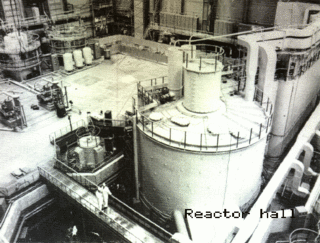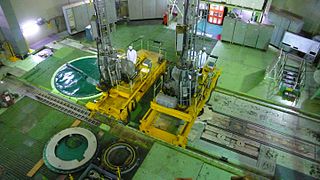The BN-reactor is a type of sodium-cooled fast breeder reactor built in Russia from the company OKBM Afrikantov. Two BN-reactors are to date (2015) the only commercial fast breeder reactors in operation worldwide.
The BN-reactor is a type of sodium-cooled fast breeder reactor built in Russia from the company OKBM Afrikantov. Two BN-reactors are to date (2015) the only commercial fast breeder reactors in operation worldwide.
The BN-350 is the first prototype of the series, in operation between 1973 and 1999 for electricity production (150MW) and desalination.
The BN-600 is a commercial reactor with 600MW electrical power. In operation since 1980 with an availability factor of over 74% it is together with Phénix one of the most successful fast breeder reactors ever built.
The BN-800 is the newest reactor of this type, with a planned electrical output of 880MW. It became first critical in 2015, electricity production was planned starting in 2017, but began in December 2015.
The BN-1200 is a 1200MW reactor project planned to reach the safety and efficiency goals of the Generation IV.

A nuclear reactor is a device used to initiate and control a fission nuclear chain reaction or nuclear fusion reactions. Nuclear reactors are used at nuclear power plants for electricity generation and in nuclear marine propulsion. Heat from nuclear fission is passed to a working fluid, which in turn runs through steam turbines. These either drive a ship's propellers or turn electrical generators' shafts. Nuclear generated steam in principle can be used for industrial process heat or for district heating. Some reactors are used to produce isotopes for medical and industrial use, or for production of weapons-grade plutonium. As of 2022, the International Atomic Energy Agency reports there are 422 nuclear power reactors and 223 nuclear research reactors in operation around the world.

A breeder reactor is a nuclear reactor that generates more fissile material than it consumes. These reactors can be fuelled with more commonly available isotopes of uranium and thorium, such as uranium-238 or thorium-232, as opposed to the rare uranium-235 which is used in conventional reactors. These materials are called fertile materials since they can be bred into fuel by these breeder reactors.

Phénix was a small-scale prototype fast breeder reactor, located at the Marcoule nuclear site, near Orange, France. It was a pool-type liquid-metal fast breeder reactor cooled with liquid sodium. It generated 590 MW of thermal power, and had a breeding ratio of 1.16, but normally had to be stopped for refueling operations every two months. Phénix continued operating after the closure of the subsequent full-scale prototype Superphénix in 1997. After 2004, its main use was investigation of transmutation of nuclear waste while also generating some electricity. Phénix was shut down in 2009.

A fast-neutron reactor (FNR) or fast-spectrum reactor or simply a fast reactor is a category of nuclear reactor in which the fission chain reaction is sustained by fast neutrons, as opposed to slow thermal neutrons used in thermal-neutron reactors. Such a fast reactor needs no neutron moderator, but requires fuel that is relatively rich in fissile material when compared to that required for a thermal-neutron reactor. Around 20 land based fast reactors have been built, accumulating over 400 reactor years of operation globally. The largest of this was the Superphénix Sodium cooled fast reactor in France that was designed to deliver 1,242 MWe. Fast reactors have been intensely studied since the 1950s, as they provide certain decisive advantages over the existing fleet of water cooled and water moderated reactors. These are:
Generation IV reactors are nuclear reactor design technologies that are envisioned as successors of generation III reactors. The Generation IV International Forum (GIF) - an international organization that coordinates the development of generation IV reactors - specifically selected six reactor technologies as candidates for generation IV reactors. The designs target improved safety, sustainability, efficiency, and cost. The first commercial Gen IV plants are not expected before 2040–2050, although the World Nuclear Association in 2015 suggested that some might enter commercial operation before 2030.

The lead-cooled fast reactor is a nuclear reactor design that features a fast neutron spectrum and molten lead or lead-bismuth eutectic coolant. Molten lead or lead-bismuth eutectic can be used as the primary coolant because especially lead, and to a lesser degree bismuth have low neutron absorption and relatively low melting points. Neutrons are slowed less by interaction with these heavy nuclei and therefore, help make this type of reactor a fast-neutron reactor. In simple terms, if a neutron hits a particle with a similar mass, it tends to lose kinetic energy. In contrast, if it hits a much heavier atom such as lead, the neutron will "bounce off" without losing this energy. The coolant does, however, serve as a neutron reflector, returning some escaping neutrons to the core. Fuel designs being explored for this reactor scheme include fertile uranium as a metal, metal oxide or metal nitride. Smaller capacity lead-cooled fast reactors can be cooled by natural convection, while larger designs use forced circulation in normal power operation, but will employ natural circulation emergency cooling. No operator interference is required, nor pumping of any kind to cool the residual heat of the reactor after shutdown. The reactor outlet coolant temperature is typically in the range of 500 to 600 °C, possibly ranging over 800 °C with advanced materials for later designs. Temperatures higher than 800 °C are theoretically high enough to support thermochemical production of hydrogen through the sulfur-iodine cycle, although this has not been demonstrated.

A sodium-cooled fast reactor is a fast neutron reactor cooled by liquid sodium.

Madras Atomic Power Station (MAPS) located at Kalpakkam about 80 kilometres (50 mi) south of Chennai, India, is a comprehensive nuclear power production, fuel reprocessing, and waste treatment facility that includes plutonium fuel fabrication for fast breeder reactors (FBRs). It is also India's first fully indigenously constructed nuclear power station, with two units each generating 220 MW of electricity. The first and second units of the station went critical in 1983 and 1985, respectively. The station has reactors housed in a reactor building with double shell containment improving protection also in the case of a loss-of-coolant accident. An Interim Storage Facility (ISF) is also located in Kalpakkam.

The BN-600 reactor is a sodium-cooled fast breeder reactor, built at the Beloyarsk Nuclear Power Station, in Zarechny, Sverdlovsk Oblast, Russia. It has a 600 MWe gross capacity and a 560 MWe net capacity, dispatched o the Middle Urals power grid. It has been in operation since 1980 and represents an evolution on the preceding BN-350 reactor. In 2014, its larger sister reactor, the BN-800 reactor began operation.

The Beloyarsk Nuclear Power Station was the third of the Soviet Union's nuclear plants. It is situated by Zarechny in Sverdlovsk Oblast, Russia. Zarechny township was created to service the station, which is named after the Beloyarsky District. The closest city is Yekaterinburg.

The BN-350 is a sodium-cooled, fast reactor located at the Mangyshlak Nuclear Power Plant, located in Aktau, Kazakhstan, on the shore of the Caspian Sea.
A liquid metal cooled nuclear reactor, or LMR is a type of nuclear reactor where the primary coolant is a liquid metal. Liquid metal cooled reactors were first adapted for breeder reactor power generation. They have also been used to power nuclear submarines.

The SNR-300 was a fast breeder sodium-cooled nuclear reactor built near the town of Kalkar, North Rhine-Westphalia, Germany. The reactor was completed but never taken online. SNR-300 was to output 327 megawatts. The project cost about 7 billion Deutsche Mark. The site is now the location of a theme park, Wunderland Kalkar, which incorporates much of the power plant buildings into the scenery.
In nuclear power technology, online refuelling is a technique for changing the fuel of a nuclear reactor while the reactor is critical. This allows the reactor to continue to generate electricity during routine refuelling, and therefore improve the availability and profitability of the plant.
The BN-800 reactor is a sodium-cooled fast breeder reactor, built at the Beloyarsk Nuclear Power Station, in Zarechny, Sverdlovsk Oblast, Russia. The reactor is designed to generate 880 MW of electrical power. The plant was considered part of the weapons-grade Plutonium Management and Disposition Agreement signed between the United States and Russia, with the reactor being part of the final step for a plutonium-burner core The plant reached its full power production in August 2016. According to Russian business journal Kommersant, the BN-800 project cost 140.6 billion rubles.

The BN-1200 reactor is a sodium-cooled fast breeder reactor project, under development by OKBM Afrikantov in Zarechny, Russia. The BN-1200 is based on the earlier BN-600 and especially BN-800, with which it shares a number of features. The reactor's name comes from its electrical output, nominally 1220 MWe.
ASTRID was a proposal for a 600 MW sodium-cooled fast breeder reactor, proposed by the Commissariat à l'énergie atomique (CEA). It was to be built on the Marcoule Nuclear Site in France. It was the successor of the three French fast reactors Rapsodie, Phénix and Superphénix.
The BREST reactor is a Russian concept of lead-cooled fast reactor aiming to the standards of a generation IV reactor. Two designs are planned, the BREST-300 and the BREST-1200. Main characteristics of the BREST reactor are passive safety and a closed fuel cycle.
The CFR-600 is a sodium-cooled pool-type fast-neutron nuclear reactor under construction in Xiapu County, Fujian province, China, on Changbiao Island. It is a generation IV demonstration project by the China National Nuclear Corporation (CNNC). The project is also known as Xiapu fast reactor pilot project. Construction of the reactor started in late 2017. These reactors are expected to be connected to the grid in 2023 and 2025. The reactor will have an output of 1500 MWth thermal power and 600 MW electric power. The fuel will be supplied by TVEL, subsidiary of Rosatom, according to the agreement signed in 2019.
The utilization of nuclear power in Kazakhstan began with Kazakhstan's first nuclear power plant, the BN-350 fast-neutron reactor in Aktau, operating from 1973 to 1999, a Soviet era prototype investment preceding the BN-600 reactor. Since then, it has only operated four smaller research reactors and did not have nuclear electricity production capabilities. Kazakhstan is the number one country in the world for uranium production volumes, which is used for nuclear fuel. Current plans, reaching back to 1997, foresee the construction of two new nuclear power plants near the towns of Ulken and Kurchatov.
56°50′30″N61°19′21″E / 56.8416°N 61.3224°E